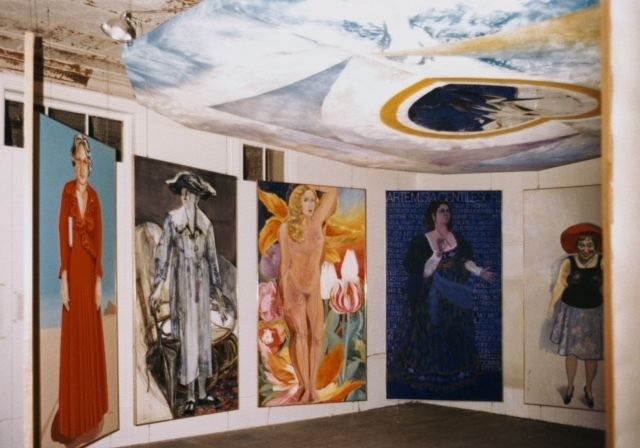 | ||
The sister chapel
The Sister Chapel is a visual arts installation, conceived by Ilise Greenstein and created by thirteen women artists during the feminist art movement. The installation premiered in January 1978 at P.S.1 in Long Island City, New York. It featured eleven panels that represented contemporary and historically significant women, deities and mythological figures, and conceptual heroic women:
Each monumental figure occupied a nine-by-five-foot canvas in a twelve-sided space, into which viewers were invited to enter. Above the eleven panels, which formed a circle around the viewers, was a circular abstract painted ceiling by Ilise Greenstein (1976). Viewers were invited to imagine and see themselves in the company of historically significant figures in developing a new way of looking at history, culture, and themselves.
A tent-like fabric enclosure, designed by Maureen Connor in 1976, was not executed, although a model was constructed and shown at the premiere exhibition.
The nominal pun regarding the Sistine Chapel ceiling was intentional. As the Sistine Chapel represented an apex of global and western culture, and a realization of the patriarchal conceptualization of history, The Sister Chapel comprised an invitation for people to re-imagine familiar, often unconscious presumptions about gender roles, recognition and relations from a female perspective. As Gloria Feman Orenstein explained in 1977, "This chapel, then, is not about the creation of man, but the birth of woman."
After its premiere at P.S.1, The Sister Chapel was exhibited at SUNY–Stony Brook (November–December 1978), Cayuga County Community College (November–December 1979), and the Associated Artists Gallery in Fayetteville, New York (March–April 1980). At the last two venues, Greenstein's Ceiling for the Sister Chapel, Wybrants's Self-Portrait as Superwoman, and Connor's model for the Chapel structure were not exhibited.
The Sister Chapel was exhibited in its entirety, for the first time in thirty-seven years, at the Rowan University Art Gallery in Glassboro, New Jersey, from March 28 through June 30, 2016. The new exhibition included Sharon Wybrants's recreation of her Self-Portrait as Superwoman because the original is lost. This was the first installation of The Sister Chapel to present the works inside the fabric enclosure designed by Maureen Connor.
